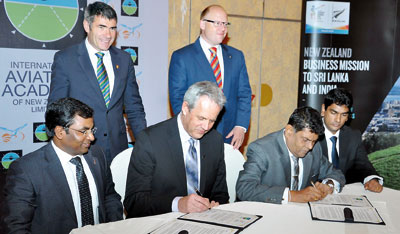First int’l flying school in Sri Lanka to train pilots
On one side while airlines are expanding globally with new aircraft and introducing new destinations, on the other side the need for more trained pilots increases. Sri Lanka has many aspiring pilots but the facilities in the country are not sufficient to obtain the required licences at the local training centres.
On Monday, the International Aviation Academy of New Zealand (IAANZ) signed a Memorandum of Understanding (MoU) with Open Skies Flight Training Ltd, a Sri Lankan pilot training academy based in Colombo. This marks the launch of an international pilot training scheme for students training to become commercial pilots. IAANZ has been training pilots for 86 years and is the first foreign school to be approved by the Civil Aviation Authority of Sri Lanka (CAA SL).

The agreement being signed. Pic by Ranjith Perera
Speaking to the Business Times on the sidelines of the event, CAA SL Director-Flight Safety Susantha De Silva said, “The International Civil Aviation Organisation (ICAO) sets standards for global aviation. When a country issues a pilot license, the pilot should be able to fly to all countries where the platform is set up by the ICAO. Based on this every state can do their own pilot training. Sri Lanka has around five flying schools and New Zealand also has quite a number. With the CAA SL-certified New Zealand flying school which is already certified by the New Zealand Federal Aviation Administration, students will be entitled to obtain the licence from both countries.”
He said IAANZ has around eight airplanes and has a lot of facilities compared to Sri Lankan flying schools. Open Skies Aviation will share their expertise in knowledge and theory. “They will do the Private Pilot Licence (PPL) and then train the students with the ground school up to Airline Transport Pilot Licence (ATPL). Then they will be sent to Christchurch in New Zealand to complete advanced training to receive a CAA SL Commercial Pilot Licence (CPL) certification,” added Mr. Silva.
IAANZ CEO Peter Randle also told the Business Times that the market for pilots is growing in the next 15 years. IAANZ does not compete on price but high quality standard of training for students. To obtain the New Zealand CPL a student requires 200 hours of flying whereas the CAA SL requires only 180 hours, added Mr. Randle.
The Asian region is expected to become the hub of aviation growth in the years ahead. This understanding between IAANZ and Open Skies puts Sri Lanka in a strategic position to supply quality pilots as per demand, he said.


